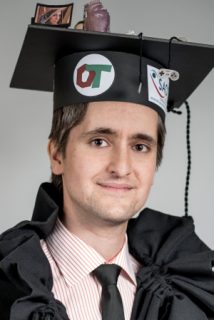Oliver Taubmann
Dynamic Cardiac Chamber Imaging in C-arm Computed Tomography
Cardiovascular diseases, i.e. disorders pertaining to the heart and blood vessels, are a major cause of mortality in developed countries. Many of these disorders, such as stenoses and some cases of valvular dysfunction, can be diagnosed and treated minimally invasively in percutaneous, catheter-based interventions. Navigation of the catheters as well as assessment and guidance of these procedures rely on interventional X-ray projection imaging performed using an angiographic C-arm device.From rotational angiography acquisitions, during which the C-arm rotates on a circular trajectory around the patient, volumetric images can be reconstructed similarly to conventional computed tomography (CT). A three-dimensional representation of the beating heart allowing for a comprehensive functional analysis during the intervention would be useful for clinicians. However, due to the slow rotational speed of the C-arm and the resulting inconsistency of the raw data, imaging dynamic objects is challenging. More precisely, only small, substantially undersampled subsets of the data, which correspond to the same cardiac phases, are approximately consistent. This causes severe undersampling artifacts in the images unless sophisticated reconstruction algorithms are employed. The goal of this thesis is to develop and evaluate such methods in order to improve the quality of dynamic imaging of cardiac chambers in C-arm CT.One of the two approaches that is investigated in this work aims to mitigate raw data inconsistencies by compensating for the heart motion. It relies on a non-rigid motion estimate obtained from a preliminary reconstruction by means of image registration. We develop a pipeline for artifact reduction and denoising of these preliminary images that increases the robustness of motion estimation and thus removes artificial motion patterns in the final images. We also propose an iterative scheme alternating motion estimation and compensation combined with spatio-temporal smoothing to further improve both image quality and accuracy of motion estimation. Furthermore, we design an open-source tool for comparing motion-compensated reconstruction methods in terms of edge sharpness.The other approach formulates reconstruction as an optimization problem and introduces prior models of the image appearance in order to find a suitable solution. In particular, sparsity-based regularization as suggested by compressed sensing theory proves beneficial. We investigate and compare temporal regularizers, which yield considerable image quality improvements. In a task-based evaluation concerned with functional analysis of the left ventricle, we study how spatio-temporally regularized reconstruction, carried out with a state-of-the-art proximal algorithm, degrades when the number of projection views is reduced. Finally, we devise a correction scheme that enables dynamic reconstruction of a volume of interest in order to reduce computational effort.Compared to one another, the approaches exhibit differences with regard to the appearance of the reconstructed images in general and the cardiac motion in particular. A straightforward combination of the methods yields a trade-off between these properties. All in all, both the hybrid and the individual approaches are able to reconstruct dynamic cardiac images with good quality in light of the challenges of rotational angiography.
